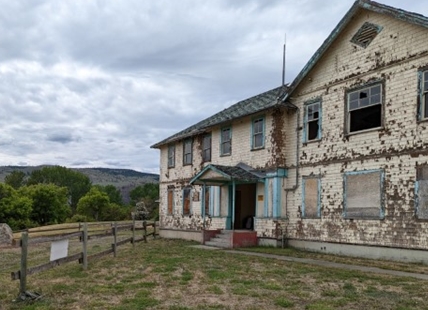How Kelowna can help build housing faster all over BC
Every city in the province is unique and most would resent being compared to Kelowna.
But they’re all suddenly being forced by the province to adopt new zoning rules Kelowna was well ahead of them on — allowing up to four units on most single family lots. There's also a June 30 deadline which means there has probably never been a better time in BC’s history for everyone to start working from the same template.
In this case, it’s the City of Kelowna that has already created that template.
“Everything is going to be quite similar so, you would think, that the same process that Kelowna has, Vernon can have, Kamloops can have, Osoyoos can have,” Terry Barton, the City of Vernon’s director of planning and community services told iNFOnews.ca.
“Never before has it been more narrow and more prescriptive so that we can get together and have something very, very similar. I think the time is right to be able to have those discussions and shared resources. I’m hoping there’s a more collaborative process that emerges.”
Kelowna is at the centre of this discussion – not just regionally but provincially – because it has been pushing for this so-called infill development since 2017 and was already working on expanding that concept before the province decided to force it on everyone. That means Kelowna’s bylaws have been updated well in advance of most, if not all other communities in BC.
READ MORE: More than 27,000 Kelowna lots targeted for more crowding with infill housing
While a consist approach could save time and money, there are some strong cautionary notes being sounded, including by Barton himself.
He spent 20 years in the Kelowna planning department, rising to a senior management position before taking the top job in Vernon last August.
“It relates to values,” Barton said. “Through the democratic process every community, over the years, has chosen a different value set on how they want to develop.
“There’s some communities, like Kelowna, that have kind of embraced the ‘all development is good development’ idea. But there are other communities out there that don’t want that same level of change. They are more picky or more choosy or they only want a little bit of development or more incremental development so they send different messages out.
“You pick the kind of community you want to live in. If you want to live in a fast, dynamic, changing place like Kelowna then, hey, you move there. If you want to live in a more historic, status quo kind of place, maybe you pick Summerland.”
While the current changes are dramatic, they do follow a pattern, Ron Mattiussi, Kelowna’s retired former city manager who now consults on these issues throughout BC, told iNFOnews.ca.
“I’ve been around for 25 years and every four or five years every government – whether it's NDP or Liberal – have added more requirements for municipalities to put in their plans,” he said. “It's downloading.
“Now you need policies to deal with streamside protection. Once upon a time they had a Ministry of Environment who looked after that. Now municipalities have to put a policy in their plans. Environmental policies, heritage policies, climate change policies, you name it. About every five years we were required to put stuff in our plan.”
Municipalities dutifully followed those directions.
“I’ve looked at some of these communities,” Mattiussi said. “They have like 60 goals, 200 objectives, 600 policies. Nobody ever looked at the cumulative effect of that.”
Now they’ve had a bunch more changes dumped in their laps and a very short time to put them in place.
“Quite frankly, there really shouldn’t be differences in processes,” Mattiussi said. “It’s the same legislation. You should know, when I come in with an application, this is what’s going to happen. This is what I need to provide. It’s going to take X amount of time. It’s going to be circulated or not. All those things really shouldn’t change by municipality.”
But it can’t be too restrictive, according to Emilie K. Adin, president of the Planning Institute of BC.
“Developers will say: ‘We want absolute clarity. We want absolute transparency. We want absolute consistency.’ Until they don’t,” she told iNFOnews.ca.
“What I mean by that is, they don’t want any exceptionalism on the part of the local jurisdiction but they ask for exceptionalism because they themselves often see that the circumstances of the site are unique.”
Not only are sites different because of geography or topography, but service agreements vary, some utilities are above ground while others are underground. And, as Barton alluded to, there are different political and organizational cultures.
“As long as the planners have the right admin supporting good development in the right places and are focused on solutions, even with the complexity of the sites, then they get to the finish line a lot more than if it’s a robot that can’t be reasonable about exceptions to the rules,” Adin said.
The institute is not pushing for standardization but, especially in the current climate, is supporting it.
Over the next few weeks, it will put on six regional forums to help draw municipalities together into working groups to share the load. And the institute is always supporting the sharing of best practices.
READ MORE: No public hearing needed for infill housing in Okanagan, Kamloops
But, if there is going to be a real wave a standardization, it’s unclear who is going to lead that.
“I don’t know that’s our role as much as we’re bringing together the different voices so we can work together to give sound advice to the decision makers and collaborate with each other,” Adin said.
Mattiussi suggested that now is the time for the province to take the lead by using a carrot rather than the heavy stick that the infill rules have been.
“This is an easy win,” he said. “Take the Kelowna process – or someone else’s – I’m sure Kelowna would provide that information to the province and the province could say: ‘We will provide the funding if you will adopt this process.’ So they’re standard. That’s how they would do it, I think, literally give it to people."
Such grants are commonly administered through the Union of BC Municipalities.
Such a change will not, of course, be in time to meet the current challenge or the ongoing scramble to find enough planners in a continually booming province.
“It’s not only the number of planners that’s at issue,” Adin said. “That’s certainly a concern. But also the number of trained planners with the right kind and level of training as well as localized knowledge of circumstances, service agreements, processes, procedures, bylaws,” Adin said. “There’s just a steep learning curve when planners move from one local authority to another.”
There’s a wave of retirements hitting the planning community, like so many other industries.
Not only is there the steep learning curve required to train new planners but most of them have Masters degrees so their training can take six years.
While bylaws vary from city to city, legislative rules are different between provinces so it’s an even steeper learning curve to hire planners from other provinces or countries.
Efforts are being made to make it easier for outside planners to qualify in BC but, for the foreseeable future, there’s not going to be any shortage of jobs for people wanting to help plan that future.
To contact a reporter for this story, email Rob Munro or call 250-808-0143 or email the editor. You can also submit photos, videos or news tips to the newsroom and be entered to win a monthly prize draw.
We welcome your comments and opinions on our stories but play nice. We won't censor or delete comments unless they contain off-topic statements or links, unnecessary vulgarity, false facts, spam or obviously fake profiles. If you have any concerns about what you see in comments, email the editor in the link above. SUBSCRIBE to our awesome newsletter here.










